How University Foundations Circumvent Conflict of Interest Disclosure Rules and Hide Corporate Ties to Faculty
More Information
By Dr. Mercola
In the last few years, freedom of information act (FOIA) requests have revealed a loophole that allows corporations to hide funds given to university-based researchers and academics, thereby also hiding their behind-the-scenes collaborations to promote corporate viewpoints while maintaining an air of independence. A recent defamation suit offers an intriguing opportunity to shed even more light on this, what appears to be, common practice.
FOIA Documents Revealed Professor’s Big Ag Links
Kevin Folta — a plant scientist and professor at the University of Florida and an outspoken advocate of genetic engineering — became a posterchild for this kind of disclosure avoidance when, two years ago, a FOIA request by the California-based activist group US Right to Know (USRTK) produced correspondence revealing Folta had instructed Monsanto on how to avoid disclosing funding his work by depositing the money into the university’s SHARE (Special Help for Agricultural Research and Education) contribution account.
As noted by Folta in his proposal to Monsanto,1 “a SHARE contribution … is not subject to IDC and is not in a conflict-of-interest account. In other words, SHARE contributions are not publicly noted. This eliminates the potential concern of the funding organization influencing the message.” Put another way, by making a SHARE contribution, the link between Folta and Monsanto would remain hidden, and his public promotion of biotech would not be tainted by obvious suspicions of conflicts of interest.
This is one of the biggest scams going. Universities have very strict conflict of interest rules in place, all of which are effectively circumvented by giving the funds as a grant to the University of Florida Foundation, which operates as a separate, non-public entity. The foundation then issues the money to individual researchers’ programs. Yet, even though the money can be easily earmarked for a specific individual or program, financial contributions to the foundation do not need to be publicly disclosed.
While this loophole is news for many, evidence suggests researchers and academics have routinely used it to avoid conflicts of interest disclosure rules. Bruce Chassy was caught doing the same thing. An investigation by Chicago WBEZ news discovered Monsanto paid the now retired University of Illinois’ professor more than $57,000 over two years for travel, writing and speaking expenses, yet Chassy never disclosed his financial ties to the company on state and university conflict of interest disclosure forms.2
This is a Flash-based audio and may not be playable on mobile devices.
How Universities Incentivize Nondisclosure of Conflicts of Interest
Nondisclosure of conflicts of interest are in some ways actually incentivized at universities. Most donations to university foundations are granted a waiver for indirect costs (IDCs).
As explained by the National Science Foundation, IDCs are “costs which are not readily identifiable with a particular cost objective (e.g., direct organizational activity or project), but nevertheless are necessary for the general operation of an organization.”3 Examples of such overhead costs include salaries for accountants and miscellaneous personnel, rent, utilities, computers and software, just to name a few.
This was the case for both Chassy and Folta. By being granted a waiver for IDCs, the burden of these costs is shifted to the students of the university and taxpayers by way of tuition and government funding. So, corporations are essentially piggybacking on students and taxpayers by getting waivers of IDC while simultaneously keeping their funding hidden. Papers have been written about how this system impacts taxpayer funded research (research funded by government grants).
As noted by the Sponsored Research Administration4 at Florida State University, “It is important to remember that the inclusion of these charges results in the support of research efforts across the campus. To request waivers of negotiated and allowable charges means a decreased SRAD [Sponsored Research and Development Trust Fund] pool and a corresponding reduction in the research and creative activities that the university stimulates and supports.”
In their paper, “The Economics of University Indirect Cost Reimbursement in Federal Research Grants,” Roger Noll and William Rogerson write:5
“The federal government has been the most important source of funds for academic research since the 1950s. Nearly a third of this support takes the form of indirect cost recovery (overhead). Long a source of conflict between universities and the government, in recent years the indirect cost controversy has escalated, with most research universities intensively investigated for alleged abuses …
[B]oth universities and the federal government would be better off if the existing indirect cost reimbursement system were replaced by a system of fixed reimbursement rates that were not related to a university’s actual indirect costs.”
Paid Academics Become Part of Industry-Controlled PR Arm
Folta publicly stated he had “no formal connection to Monsanto”6 and denied ever accepting payments from Big Ag, including Monsanto.7 The FOIA request and subsequent publication of the correspondence between Folta and Monsanto created an abrupt end to Folta’s status as an independent expert on genetically modified organisms (GMOs).
The documents clearly show Monsanto paid Folta to travel around the country to speak about the merits of GMOs. As Folta himself put it: “I’m glad to sign on to whatever you like, or write whatever you like.”.8
At the time, Gary Ruskin, executive director of USRTK told Nature,9 “I think it’s important for professors who take money from industry to disclose it. And if they’re not disclosing it, that’s a problem. And if they say they aren’t taking money, and they are, then that’s a problem.”
The documents also revealed the biotechnology PR firm Ketchum drafted answers directed to Folta on the GMO Answers website. While Folta claimed he typically ignored the prewritten answers, it shows that paid academics and researchers are part of a tightly controlled PR arm of the industry.
Once the $25,000 unrestricted grant from Monsanto (funneled through the University Foundation to avoid disclosure) became publicly known, the money was reallocated to a local food pantry. Folta claims he “talked to Monsanto about returning the money,” but that the company was “totally against it” because “it looks like an admission of guilt.”10 The ironic part is that by re-donating the money to a food pantry, they confirm that the money was indeed earmarked for Folta and no one else.
Folta Files Defamation Suit Against New York Times
The New York Times (NYT) was among the first to report Folta’s conflicts of interest.11 Now, Folta has filed a defamation suit12 against the paper and journalist Eric Lipton, who wrote the article. In his suit, Folta claims his “academic reputation was unfairly tarnished, his health harmed and his personal safety jeopardized” by Lipton’s “scandalous” article. According to the Cornell Alliance for Science: 13
“Folta … contends that Lipton and the NYT intentionally ‘misrepresented him as a covertly paid operative’ of Monsanto in order to further their own ‘anti-GMO agenda.’ The NYT article had identified him, for example, as an ‘aggressive biotech proponent with financial ties to Monsanto,’ a claim Folta strongly refutes.
Folta … told the Alliance for Science that he filed the lawsuit both to stop the ‘spiral of silence’ that such reporting creates among other academics and also to regain his reputation.
‘When you’re portrayed as trading lobbying for grant money, that’s the kiss of death … You realize that you’re the walking dead in your career.’ Folta said other scientists have told him they are now reluctant to speak up publicly on the controversy around GMOs because they feared the harm that could come to them from similar adverse coverage.”
The NYT has vowed to “defend the lawsuit vigorously,” adding that, “Our story was carefully researched and the documents underlying the story were posted online to give readers the opportunity to see for themselves the research we developed and relied upon.” It is seriously unlikely that Folta can prevail against the NYT’s legal team and deep pockets, especially considering some of the arguments brought forth in his suit. Take paragraph 40, for example, which reads:14
“The Defendants deliberately chose the caption “if you spend enough time with skunks, you start to smell like one” to insinuate that Dr. Folta is a “skunk.” This was offensive, malicious, and reckless.”
The lawsuit also addresses Folta’s upset at being blocked by Lipton on Twitter. Paragraph 136 of Folta’s suit reads:
“In order to cause even more mental harm to Dr. Folta, Defendant Lipton then blocked Dr. Folta from viewing Lipton’s malicious tweets, so that Dr. Folta was not even able to see what defamatory and harmful words Lipton was publishing next, even though it was, in fact, Lipton who was targeting Dr. Folta, and never vice versa.”
The Real Story — University Foundations Serve to Hide Conflicts of Interest
I think it’s important to realize that the real story here is the fact that money laundering is occurring through universities, and how it’s occurring. In order to clamp down on undisclosed conflicts of interest, this loophole really needs to be fully exposed — and closed. NYT lawyers have a unique opportunity to do just that here, were they to insist on calling in the administrators, internal managers and accountants of the SHARE program for deposition.
I don’t think Folta realizes that by suing the NYT, he opens the door for them to blow this whole nondisclosure sham wide-open. All they have to do is ask the administrators if it’s routine to accept corporate grants and earmark them for specific individuals or projects — in other words, is the program being routinely used to hide corporate conflict of interest connections? Remember, professors are in fact incentivized to hide corporate conflicts of interest and to bypass IDC recovery, shifting those costs onto students and taxpayers instead.
Were the NYT to do so, it could turn into a truly huge story with massive ramifications. It could go a very long way toward forcing greater transparency. When corporate funding of university professors remains undisclosed, it not only deceives the public, it also undermines education.
The fact that the University of Florida Foundation deleted a number of its “honor roll donors” for 2013/201415 — right around the same time that the NYT revealed Folta’s industry connections — only adds to suspicions that corporate funding is in fact being hidden through its SHARE program.
The following are screenshots of deleted donors, captured when the initial FOIA responses were received, in anticipation that they might be removed (a hunch over at USRTK that turned out to be correct). Deleted donors include BASF, Bayer, Syngenta, Pioneer, Monsanto and Dow Chemical. “Gold” donors, such as Monsanto and BASF, have donated more than $1 million. “Diamond” donors such as Syngenta have donated in excess of $10 million.
These screenshots are the only public evidence remaining that these donations were made; these webpages are not even available using Wayback Machine. So, just how much of these millions of dollars were in fact earmarked and funneled to specific faculty members to avoid public scrutiny?
It’s also worth noting the following quote on the very last screen shot: “The Foundation … also serves as fiduciary, taking care of the gift assets to ensure they are used in accordance with our donors’ wishes” — yet another glaring piece of evidence suggesting that donations are earmarked for certain individuals and can thus be “laundered” through the Foundation without having to be publicly disclosed.
|
|
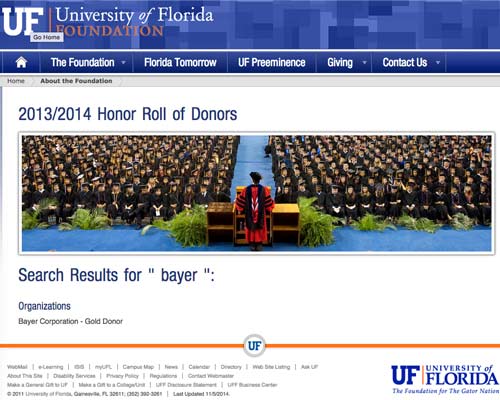 |
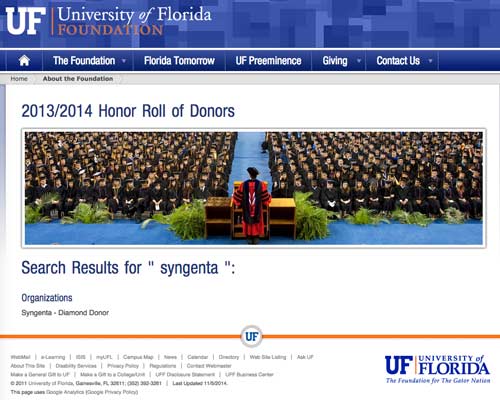 |
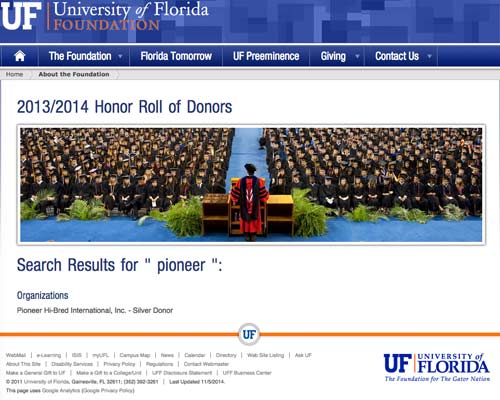 |
 |
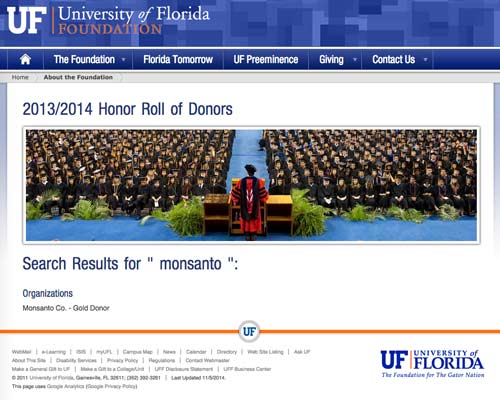 |
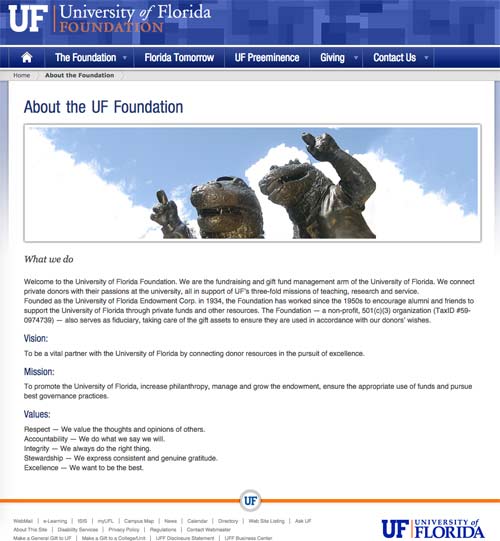 |
|
USRTK Sues University of Florida
In a separate twist, USRTK is suing the University of Florida for failure to provide all the emails required by freedom-of-information law.16,17 In a July 11 press release, USRTK explains its lawsuit is aimed to:18
” … [C]ompel the University of Florida to comply with public records requests about the university’s relationship with agrichemical companies that produce genetically engineered seeds and pesticides. ‘We are conducting an investigation of the food and agrichemical industries, their front groups and public relations operatives, their ties to universities, and the health risks of their products, said Gary Ruskin, co-director of U.S. Right to Know.
‘The public has a right to know if and when taxpayer-funded universities and academics are collaborating with corporations to promote their products and viewpoints.'”
The NYT article that gave rise to Folta’s defamation suit was in large part based on the records obtained by USRTK from the University of Florida. But Folta was only one of dozens of individuals for whom the USRTK sought correspondence, to assess hidden ties between the university and the agrichemical industry.
One of them is Jack M. Payne, senior vice president for agriculture and natural resources at the University of Florida. USRTK specifically requested correspondence sent between Payne and employees of the University of Florida Foundation.
In mid-December 2015, the university handed over 42 pages, but refused to release any remaining documents. Considering the University Foundation deleted stellar donors from their site only makes obtaining correspondence with Foundation employees all the more pertinent.
Yet, even though emails were sent to and from a university email address, the University of Florida claims the emails did not involve official university business and therefore shouldn’t be made public. Apparently, the University of Florida is none too fond of transparency in general.
According to USRTK, “Professor Payne is not an employee of the Foundation, and email communications sent or received by him in the course of official business are public records,” adding that even if the court were to find some of the emails could be exempt, “the proper procedure would be to require Defendant to furnish the documents to the Court for an in camera inspection.”
College Foundation Caught Misspending Funds
There are more reasons than one for wanting to avoid public scrutiny of Foundation funds. A 2015 article19 by Columbia Journalism Review revealed the case of Robert Breuder, president of DuPage College. Breuder was found to have expensed hunting excursions, expensive wines, dinners and other frivolous, personal expenses to the College of DuPage Foundation, the mission of which is to raise funds for student scholarships.
The Chicago Tribune requested documents related to Breuder’s spending under the state public-records law, but was told such records were unavailable. It wasn’t until the Tribune filed a lawsuit to compel disclosure that Breuder’s misspending came to light. A refrain common to many college and university foundations is noted in this article:
“In its answer to the Tribune’s complaint, the college … denies that the foundation is a public body or a subsidiary of one. It denies that the foundation is contracted with a public body to perform public functions on the college’s behalf. And, thus, it denies that the foundation is subject to the public-records law.”
The Tribune, meanwhile, argued “the college is using its foundation, housed on campus and staffed by college employees, ‘as an artifice to circumvent’ the law: ‘The foundation is mostly or entirely under the control of [the college, which] has been using the existence of the foundation as an excuse or a subterfuge to shield its financial records and expenditures from public view.'”
Watchdog Journalism Is a Vital Public Service
Jake Griffin, assistant managing editor for watchdog reporting at the Daily Herald said: “What good does it serve to keep the activities of the foundation free of public scrutiny and oversight, especially considering [that it’s] using the auspices of the college as the means for generating funding?”
As suggested by Columbia Journalism Review, journalists play a vital role when it comes to keeping public organizations honest and the public informed. Folta may blame the NYT for the unraveling of his career and health, but the evidence shows he was collaborating with industry and denied it.
It if weren’t for Lipton and other journalists, he’d still be pulling the wool over everyone’s eyes. Even though Folta still maintains he had no financial ties to Monsanto, the evidence shows he did, so it would appear he’s suing the NYT to intimidate journalists from exposing these undisclosed conflicts of interest.
Last year, David Cuillier, director of the University of Arizona School of Journalism said,20 “I think there are a ton of flags that need to be raised when it comes to university foundations. I think it’s one of the most underreported scams in America. It’s total slush fund … What a great way to hide money for a university.”
Indeed. It appears it has been a marvelous way to throw a veil over potential funding bias, educational bias and all sorts of conflicts of interest. The fact that this is now coming to light is good news for everyone except those trying to hide their wrongdoings. And, if we’re lucky, NYT attorneys will depose the University of Florida Foundation’s administrators and accountants, to give us all a clearer picture of the full extent of this scam.
Source:: Mercola Health Articles


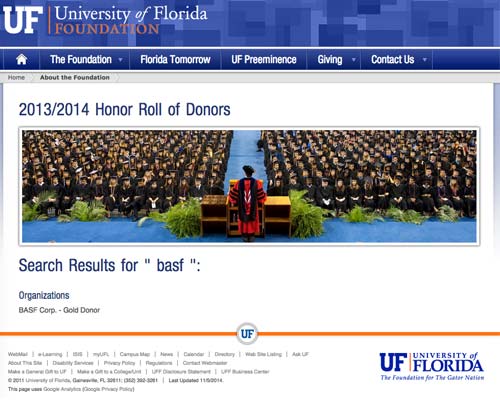

 Body Charge Nutrition is a premium nutritional supplement provider based in Western Canada offering only products and information that are of the highest quality and integrity. Through knowledge and personal experience, it is our goal to assist you with taking control of your health.
Body Charge Nutrition is a premium nutritional supplement provider based in Western Canada offering only products and information that are of the highest quality and integrity. Through knowledge and personal experience, it is our goal to assist you with taking control of your health.